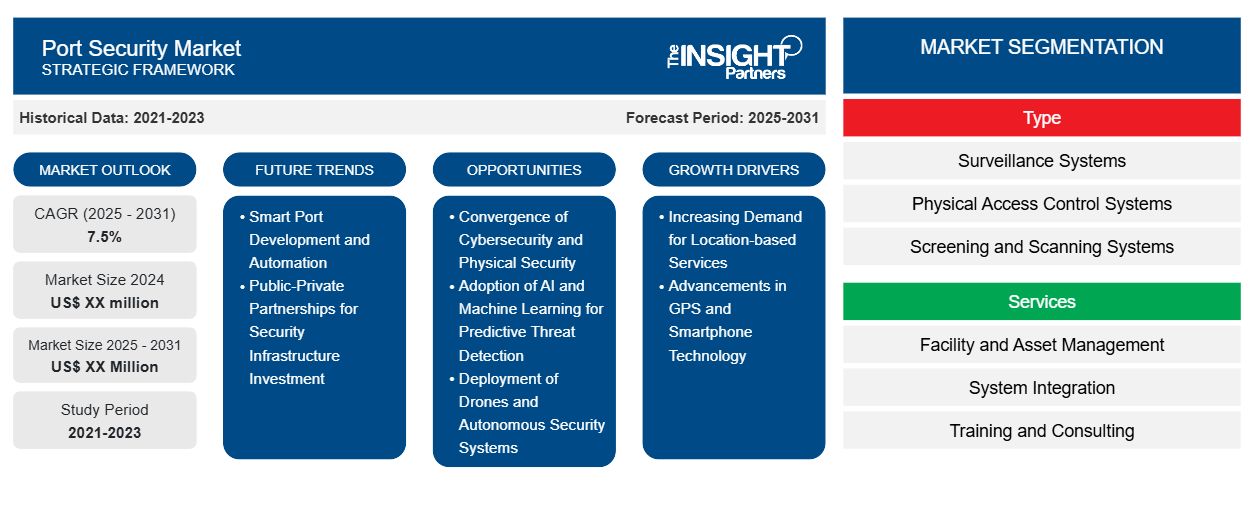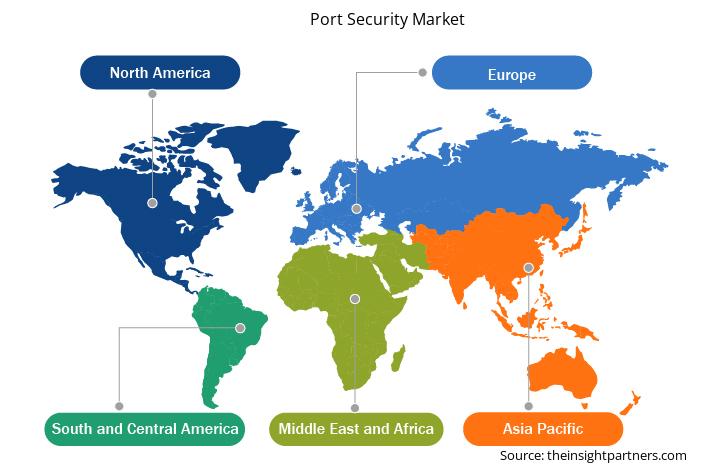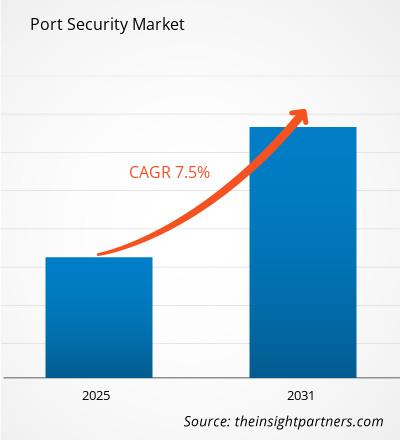预计港口安全市场在 2025 年至 2031 年期间的复合年增长率为 7.5%,市场规模将从 2024 年的 XX 百万美元扩大到 2031 年的 XX 百万美元。CAGR of 7.5% from 2025 to 2031, with a market size expanding from US$ XX million in 2024 to US$ XX Million by 2031.
该报告按类型(监控系统、物理门禁系统、筛查和扫描系统、周界入侵检测系统和实时定位系统)和服务(设施和资产管理、系统集成、培训和咨询)进行细分。全球分析进一步细分为区域和主要国家。报告提供上述分析和细分的美元价值。
报告目的
Insight Partners 发布的《港口安全市场》报告旨在描述港口安全市场的现状和未来增长、主要驱动因素、挑战和机遇。该报告将为各业务利益相关者提供见解,例如:
- 技术提供商/制造商:了解不断变化的市场动态并了解潜在的增长机会,使他们能够做出明智的战略决策。
- 投资者:对市场增长率、市场财务预测以及整个价值链中存在的机会进行全面的趋势分析。
- 监管机构:规范市场政策和警察活动,旨在最大限度地减少滥用行为,维护投资者的信任和信心,维护市场的完整性和稳定性。
港口安全市场细分
类型
- 监控系统
- 物理访问控制系统
- 筛查和扫描系统
- 周界入侵检测系统
- 实时定位系统
服务
- 设施和资产管理
- 系统集成
- 培训和咨询
定制此报告以满足您的要求
您可以免费定制任何报告,包括本报告的部分内容、国家级分析、Excel 数据包,以及为初创企业和大学提供优惠和折扣
港口安全市场:战略洞察

- 获取此报告的主要市场趋势。此免费样品将包括数据分析,从市场趋势到估计和预测。
港口安全市场增长动力
- 基于位置的服务需求日益增长:基于位置的服务 (LBS) 的快速普及是移动地图市场的关键驱动力。随着企业和消费者对实时导航、地理空间分析和基于位置的营销的需求不断增长,移动地图应用已变得至关重要。无论是用于配送服务、导航应用还是个性化位置数据,对精准可靠的移动地图解决方案的需求都在不断增长,这导致交通运输、零售和物流等各行各业对这些技术的需求不断增长。
- GPS 和智能手机技术的进步:GPS 技术和智能手机功能的不断进步正在推动移动地图市场的发展。加速度计、陀螺仪和摄像头等传感器的精度、速度和集成度的提高增强了移动地图应用程序的功能。这些创新实现了更精确的定位、地图绘制和增强的用户体验,使移动地图解决方案更加可靠和有效,从而加速了市场的增长。
港口安全市场未来趋势
- 智能港口发展与自动化:随着港口通过自动化和数字化实现现代化,整合先进的安全系统以补充这些新技术将带来巨大的机遇。智能港口使用传感器、物联网和数据分析来优化港口运营,而将安全解决方案与这些技术相结合,可以无缝管理运营效率和安全。智能港口的发展催生了对先进的集成安全系统的需求,这些系统不仅能够监控物理安全,还能保护数字基础设施免受网络威胁。
- 公私合作投资安全基础设施:鉴于开发和维护先进港口安全系统的成本高昂,公私合作 (PPP) 模式提供了一个充满希望的机遇。政府可以与私营安保公司合作,共同资助、部署和管理先进技术,例如监控系统、无人机和基于人工智能的威胁检测。这种模式有助于平衡财政负担,同时确保港口安全。随着 PPP 模式的日益普及,专注于安全技术的私营公司有望从长期合同中获益,从而开辟新的收入来源。
港口安全市场机遇
- 网络安全与物理安全的融合:随着港口互联互通程度不断加深,并日益依赖数字技术,网络安全与物理安全的融合正成为一种关键趋势。针对港口系统的网络攻击可能造成毁灭性后果,危及物流、航行和运营安全。因此,港口当局越来越多地采用融合物理和网络防御措施的集成安全系统。这一趋势凸显了对先进安全解决方案日益增长的需求,这些解决方案既能保护实物资产(例如货物、船舶、设施),又能保护数字基础设施(例如通信系统、自动化控制)。
- 采用人工智能和机器学习进行预测性威胁检测:人工智能 (AI) 和机器学习 (ML) 的应用正成为港口安全的主导趋势。这些技术可以实时分析来自摄像头、传感器和船舶跟踪系统等多个来源的数据,以预测和检测潜在的安全威胁。人工智能算法可以识别人类操作员可能遗漏的大型数据集中的模式和异常,从而能够在安全事件升级之前主动做出响应。这一趋势正在彻底改变港口监控和管理风险的方式,使其更加安全、高效。
- 无人机和自主安全系统的部署:无人机和自主安全系统在港口安全领域的应用日益增多。无人机越来越多地被用于监视、检查货物和基础设施,以及监测难以到达区域的船舶动向。同样,自动驾驶汽车和机器人也被用于货物检查和周边安全等任务,从而减少了人工干预的需求,并提高了整体安全响应时间。这一趋势凸显了人们日益依赖自动化来提高港口安全运营的效率,同时降低成本和减少人为错误。
港口安全市场区域洞察
Insight Partners 的分析师已详尽阐述了预测期内影响港口安全市场的区域趋势和因素。本节还讨论了北美、欧洲、亚太地区、中东和非洲以及南美和中美洲的港口安全市场细分和地理位置。

- 获取港口安全市场的区域特定数据
港口安全市场报告范围
| 报告属性 | 细节 |
|---|---|
| 2024年的市场规模 | XX百万美元 |
| 2031年的市场规模 | XX百万美元 |
| 全球复合年增长率(2025-2031) | 7.5% |
| 史料 | 2021-2023 |
| 预测期 | 2025-2031 |
| 涵盖的领域 | 按类型
|
| 覆盖地区和国家 | 北美
|
| 市场领导者和主要公司简介 |
|
港口安全市场参与者密度:了解其对业务动态的影响
港口安全市场正在快速增长,这得益于终端用户需求的不断增长,而这些需求的驱动因素包括消费者偏好的演变、技术进步以及对产品优势的认知度的提升。随着需求的增长,企业正在扩展产品线,不断创新以满足消费者需求,并抓住新兴趋势,从而进一步推动市场增长。
市场参与者密度是指特定市场或行业内企业或公司的分布情况。它表明特定市场空间内竞争对手(市场参与者)的数量相对于其规模或总市值而言。
在港口安全市场运营的主要公司有:
- Teledyne FLIR有限责任公司
- 江森自控
- 霍尼韦尔国际公司
- 萨博公司
- 罗伯特·博世有限公司
- 西门子股份公司
免责声明:以上列出的公司没有按照任何特定顺序排列。

- 获取港口安全市场顶级关键参与者概览
主要卖点
- 全面覆盖:该报告全面涵盖了港口安全市场的产品、服务、类型和最终用户的分析,提供了整体概况。
- 专家分析:本报告基于对行业专家和分析师的深入了解而编写。
- 最新信息:该报告涵盖了最新信息和数据趋势,确保了业务相关性。
- 定制选项:此报告可以定制以满足特定客户要求并适合业务策略。
因此,港口安全市场研究报告有助于引领解读和理解行业现状及增长前景。尽管存在一些合理的担忧,但本报告的总体优势往往大于劣势。
- 历史分析(2 年)、基准年、预测(7 年)及复合年增长率
- PEST和SWOT分析
- 市场规模、价值/数量 - 全球、区域、国家
- 行业和竞争格局
- Excel 数据集
近期报告
相关报告
客户评价
购买理由
- 明智的决策
- 了解市场动态
- 竞争分析
- 客户洞察
- 市场预测
- 风险规避
- 战略规划
- 投资论证
- 识别新兴市场
- 优化营销策略
- 提升运营效率
- 顺应监管趋势




















 获取免费样品 - 港口安全市场
获取免费样品 - 港口安全市场